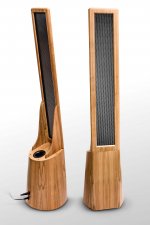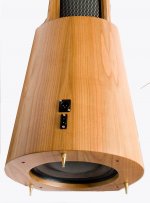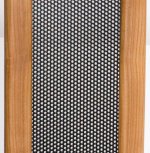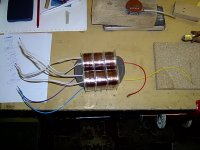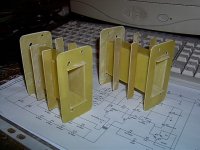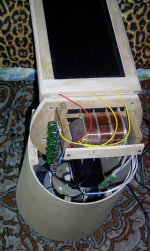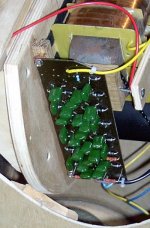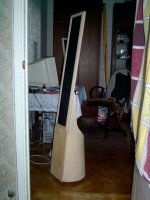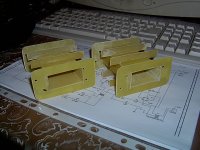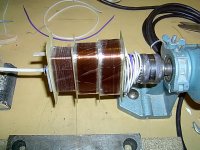Excellent hybrid speakers, here's my version. Unique-sounding, and minimum sizes. bandwidth of 35 Hz - 20000 Hz. 90dB sensitivity.
Attachments
Member
Joined 2003
Your speakers are gorgeous! Could you tell us the perf'd stator's hole size, open area & gauge thickness and also the type and thickness of the stator coating?
thanks
Charlie
thanks
Charlie
Beautiful speakers! 🙂
What material do you use for the spacers and if not tape - what type of glue did you use?
What's the XO frequency for the bass, and do you find the integration of bass reflex to work with the ESL-panel?
/R
What material do you use for the spacers and if not tape - what type of glue did you use?
What's the XO frequency for the bass, and do you find the integration of bass reflex to work with the ESL-panel?
/R
My ESL
First in the development of this ESL speaker, was tasked to obtain the maximum sensitivity of up to 90 dB with minimum size, so the ESL has dimensions of 1000mm x 180mm. And spacers 1.8mm
Second ease of manufacture, so the speaker has no supports the membrane, thus achieving its low resonance frequency equal to 100Hz.
The stators are made of perforated metal thickness of 1.0mm, transparency 42%. Covered Black PF in two layers.
For insulators used in glass fiber with thickness 1.8mm
But the main thing was to cover the membrane, because it reminds sandwich.
Mylar membrane coated on both sides of high-resistance layer of
Graphite = 5 x 10E8 ohms and above on both sides of layers of nylon 66.
that gives high sensitivity ESL speaker.
with polarization voltage = 3600V for spacers 1.8mm.
First in the development of this ESL speaker, was tasked to obtain the maximum sensitivity of up to 90 dB with minimum size, so the ESL has dimensions of 1000mm x 180mm. And spacers 1.8mm
Second ease of manufacture, so the speaker has no supports the membrane, thus achieving its low resonance frequency equal to 100Hz.
The stators are made of perforated metal thickness of 1.0mm, transparency 42%. Covered Black PF in two layers.
For insulators used in glass fiber with thickness 1.8mm
But the main thing was to cover the membrane, because it reminds sandwich.
Mylar membrane coated on both sides of high-resistance layer of
Graphite = 5 x 10E8 ohms and above on both sides of layers of nylon 66.
that gives high sensitivity ESL speaker.
with polarization voltage = 3600V for spacers 1.8mm.
Last edited:
Type of glue 88-СА.Beautiful speakers! 🙂
What material do you use for the spacers and if not tape - what type of glue did you use?
What's the XO frequency for the bass, and do you find the integration of bass reflex to work with the ESL-panel?
/R
Frequency for the bass 35Hz - 250Hz.
Hi Statics Man,
It's really beautiful. How do you measure the efficiency of your speakers to be at 90dB?
Do you use an active or passive crossover?
Wachara C.
It's really beautiful. How do you measure the efficiency of your speakers to be at 90dB?
Do you use an active or passive crossover?
Wachara C.
Last edited:
thanks for the details on your build.spec's on mine are similar and was measuring around 90db as i was pushing the bias high as i could some where between 2.5kv to 6kv until my transformer brokedown.they have been sitting dorment since 2004 and i am in the process of making them work again. jer
Hi Statics Man,
Thanks for the info. I once tried passive crossover, but I found it very difficult to match the sound volume from an ESL and a subwoofer. How do you do that?
Wachara C.
Thanks for the info. I once tried passive crossover, but I found it very difficult to match the sound volume from an ESL and a subwoofer. How do you do that?
Wachara C.
Hi.Hi Statics Man,
Thanks for the info. I once tried passive crossover, but I found it very difficult to match the sound volume from an ESL and a subwoofer. How do you do that?
Wachara C.
This is because you have very little sensitivity ESL speaker. The sensitivity of your ESL speaker less than 87 dB. And the sensitivity of the subwoofer is greater than 90 dB.
Hi Statics Man,
Ok, I'll try higher turn ratio transformers. Your transformers look really nice. Apart from sectioning, do you do interleavings as well?
Wachara C.
Ok, I'll try higher turn ratio transformers. Your transformers look really nice. Apart from sectioning, do you do interleavings as well?
Wachara C.
My ESL
Hi chinsettawong.
Scheme of the transformer (ratio transformers = 100) here.
Input winding is wound in four layers of 99 turns in each layer are connected in parallel.
Output winding is divided into three sections, 1,650 turns in each section is connected in series.
Each layer of winding insulated 20-micron mylar in two layers.
Hi Statics Man,
Ok, I'll try higher turn ratio transformers. Your transformers look really nice. Apart from sectioning, do you do interleavings as well?
Wachara C.
Hi chinsettawong.
Scheme of the transformer (ratio transformers = 100) here.
Input winding is wound in four layers of 99 turns in each layer are connected in parallel.
Output winding is divided into three sections, 1,650 turns in each section is connected in series.
Each layer of winding insulated 20-micron mylar in two layers.
Attachments
Hi Staticman,
can you tell me, which woofer will provide 90dB @ 2,84V down to 35 Hz in such a small housing ? It needs to be a 2 ohm car woofer.
I doubt your woofer to provide such sensitivity in this small housing having about 15 liter ? net
Capaciti
can you tell me, which woofer will provide 90dB @ 2,84V down to 35 Hz in such a small housing ? It needs to be a 2 ohm car woofer.
I doubt your woofer to provide such sensitivity in this small housing having about 15 liter ? net
Capaciti
Hi Staticman,
can you tell me, which woofer will provide 90dB @ 2,84V down to 35 Hz in such a small housing ? It needs to be a 2 ohm car woofer.
I doubt your woofer to provide such sensitivity in this small housing having about 15 liter ? net
Capaciti
Hi dear Capaciti.
I'm talking about sensitivity in the range of 100 Hz - 10000 Hz.
Indeed, my sub has a sensitivity of 86 dB at a frequency of 30 Hz.
Hi Staticman,
your stepup looks very good.
This design could easily drive a Fulllrange ESL. You mentioned 99 primary turns, all put parallel. In combination with the core size this will provide more than 40mH primary inductance ! On the other hand this will mean large secondary inductance as well, which limits your bandwidth.
Crossing at 250 Hz you could reduce your primary windings down to 35 turns without any negative impact. This results in reduced secondaries as well. This reduces capacity of the secondary windings significantly, improving upper bandwidth and reducing the effort to wound
So if you like to make another stepup (whoich you might deny prior to the heavy effort you had with the current ones) this modification will be a further progress. Really you did a great job
Capaciti
your stepup looks very good.
This design could easily drive a Fulllrange ESL. You mentioned 99 primary turns, all put parallel. In combination with the core size this will provide more than 40mH primary inductance ! On the other hand this will mean large secondary inductance as well, which limits your bandwidth.
Crossing at 250 Hz you could reduce your primary windings down to 35 turns without any negative impact. This results in reduced secondaries as well. This reduces capacity of the secondary windings significantly, improving upper bandwidth and reducing the effort to wound
So if you like to make another stepup (whoich you might deny prior to the heavy effort you had with the current ones) this modification will be a further progress. Really you did a great job
Capaciti
Member
Joined 2003
- Status
- Not open for further replies.
- Home
- Loudspeakers
- Planars & Exotics
- My new High-quality hybrid ESL loudspeaker
